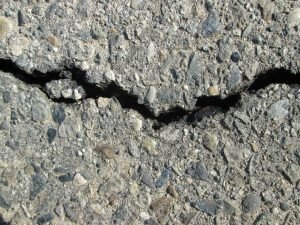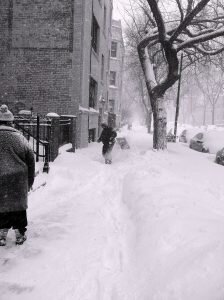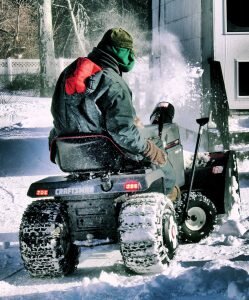Don’t Touch that Sidewalk! Doing Too Much Could Be as Problematic for Condo Associations as Doing Too Little
By Mark Einhorn and John Shaffer
We regularly advise condominium boards to be wary of taking on obligations beyond those state laws or their association’s governing documents require them to assume. A recent decision by a Massachusetts Appeals Court adds a judicial exclamation point to that advice. The decision (Eric Halbach vs. Normandy Real Estate Partners) deals with the obligations of property owners to maintain walkways. The property owner in this case owned a commercial building in downtown Boston adjacent to a public sidewalk. After a pedestrian tripped on the sidewalk, which was uneven, and sustained serious injuries because of the fall, the building owner hired a contractor to eliminate the hazard.That was the act of a good neighbor, because the city owned the sidewalk and was responsible for maintaining it. But because ‘no good deed goes unpunished,’ it was also an invitation to a law suit. The injured pedestrian sued the building owner for negligent maintenance and for failing to alert passersby to the hazard.The trial court rejected the claim, concluding that the building owner didn’t own the sidewalk and so had no duty to maintain it. The Appeals Court agreed that a property owner has no affirmative obligation to maintain an abutting public way. “Our case law establishes that such an owner…is charged [only] with the negative duty of refraining from creating an unsafe condition on the public way adjacent to his property, but no more,” the court said.The court rejected the plaintiff’s argument that by undertaking to repair the sidewalk, the building owner exercised control over it and, as a result, assumed the obligation to maintain it. “[While] a duty of care may arise from the right to control land, even where the person held to such a duty does not own the land in question,” the court said that principle did not apply in this case for two reasons:
The decision (Eric Halbach vs. Normandy Real Estate Partners) deals with the obligations of property owners to maintain walkways. The property owner in this case owned a commercial building in downtown Boston adjacent to a public sidewalk. After a pedestrian tripped on the sidewalk, which was uneven, and sustained serious injuries because of the fall, the building owner hired a contractor to eliminate the hazard.That was the act of a good neighbor, because the city owned the sidewalk and was responsible for maintaining it. But because ‘no good deed goes unpunished,’ it was also an invitation to a law suit. The injured pedestrian sued the building owner for negligent maintenance and for failing to alert passersby to the hazard.The trial court rejected the claim, concluding that the building owner didn’t own the sidewalk and so had no duty to maintain it. The Appeals Court agreed that a property owner has no affirmative obligation to maintain an abutting public way. “Our case law establishes that such an owner…is charged [only] with the negative duty of refraining from creating an unsafe condition on the public way adjacent to his property, but no more,” the court said.The court rejected the plaintiff’s argument that by undertaking to repair the sidewalk, the building owner exercised control over it and, as a result, assumed the obligation to maintain it. “[While] a duty of care may arise from the right to control land, even where the person held to such a duty does not own the land in question,” the court said that principle did not apply in this case for two reasons:
- There was no evidence that the building owner had any legal right of control over the walkway: and
- As the owner of the sidewalk, the city controlled it and had a clear statutory duty to maintain it. That conclusion “comports with the Commonwealth’s ‘elaborate and comprehensive statutory system’ establishing municipal liability for injuries resulting from defects in public ways,” the court stated.
A Win and a Warning
The 2-1 decision clearly favors private property owners, but the dissenting opinion contains a warning for them, as well, in its suggestion that that the Supreme Judicial Court might well reconsider the state law that absolves owners of the responsibility to maintain public sidewalks adjacent to their property. “At least in the context of commercial property,” the dissenting opinion notes, “the reality is that the world principally looks to private property owners to make sure that the sidewalks bordering their property are safe. It is far from self-evident why ─ under modern tort principles ─the law should not follow suit.” If the SJC ultimately agrees that the existing law should be changed, condominiums and other private property owners may well have to recognize an obligation to maintain adjacent public walkways. But for now, our advice remains: If you don’t own it, don’t do anything to suggest that you recognize a responsibility to maintain or repair it. In this case, the property owner would have been better advised to resist the good neighbor instinct, notify the city of the problem, request prompt attention to it, and, of course, document those communications.Although this case involved a public walkway for which the property owner had no maintenance obligations, it provides a good opportunity to review the general obligations of condo communities to maintain the walkways they do own. And those obligations are extensive. This is especially the case when dealing with snow and ice and the slip and fall risks those conditions create.
If the SJC ultimately agrees that the existing law should be changed, condominiums and other private property owners may well have to recognize an obligation to maintain adjacent public walkways. But for now, our advice remains: If you don’t own it, don’t do anything to suggest that you recognize a responsibility to maintain or repair it. In this case, the property owner would have been better advised to resist the good neighbor instinct, notify the city of the problem, request prompt attention to it, and, of course, document those communications.Although this case involved a public walkway for which the property owner had no maintenance obligations, it provides a good opportunity to review the general obligations of condo communities to maintain the walkways they do own. And those obligations are extensive. This is especially the case when dealing with snow and ice and the slip and fall risks those conditions create.
“Reasonable Care” Required
 The legal framework for managing those risks changed dramatically in 2010 when the SJC (in Papadopoulos v. Target Corporation) threw out the traditional theory that associations were not generally responsible for injuries resulting from the “natural accumulation of snow and ice, replacing it with a “reasonable man” standard. To avoid liability, associations must now demonstrate that they have made “reasonable efforts” to mitigate the risks created by snow and ice.Reasonable people will always disagree about what constitutes reasonable. The courts haven’t provided any definitive (binding) guidance on that question. A Superior Court took a stab at the question in a 2012 decision (John Santolucito et al. v. Demoulas Super Markets, Inc.) finding that liability might be found if otherwise reasonable snow removal actions “created or furthered [a] hazardous situation.”That still leaves associations pretty much on their own in determining what courts would view as reasonable efforts to mitigate snow and ice-related risks. Common sense is the best guide, combined with a healthy dose of diligence and some practical legal advice:
The legal framework for managing those risks changed dramatically in 2010 when the SJC (in Papadopoulos v. Target Corporation) threw out the traditional theory that associations were not generally responsible for injuries resulting from the “natural accumulation of snow and ice, replacing it with a “reasonable man” standard. To avoid liability, associations must now demonstrate that they have made “reasonable efforts” to mitigate the risks created by snow and ice.Reasonable people will always disagree about what constitutes reasonable. The courts haven’t provided any definitive (binding) guidance on that question. A Superior Court took a stab at the question in a 2012 decision (John Santolucito et al. v. Demoulas Super Markets, Inc.) finding that liability might be found if otherwise reasonable snow removal actions “created or furthered [a] hazardous situation.”That still leaves associations pretty much on their own in determining what courts would view as reasonable efforts to mitigate snow and ice-related risks. Common sense is the best guide, combined with a healthy dose of diligence and some practical legal advice:
- Adopt a “snow resolution” that delineates clearly where the association’s responsibilities for dealing with snow and ice begin and end. Common areas are clearly the association’s responsibility, but the responsibility for limited common areas (individual walkways and driveways, decks and patios) can be fuzzy. If the documents are silent and the responsibilities aren’t defined, they will fall to the association by default. Associations that don’t want that responsibility may be able to delegate it, by specifying in this resolution that owners who use limited common areas are responsible for taking care of them.
 Some boards are willing to plow and sand limited common areas when time and resources permit and hybrid maintenance arrangements of this kind are fine. But the resolution should specify that while the association may handle snow removal sometimes, primary responsibility for doing so rests with the owners.
Some boards are willing to plow and sand limited common areas when time and resources permit and hybrid maintenance arrangements of this kind are fine. But the resolution should specify that while the association may handle snow removal sometimes, primary responsibility for doing so rests with the owners.- Clarity about snow removal obligations is essential; assumptions are dangerous. A board might assume that an owner who has consistently cleared the walkway leading to the owner’s door will always do that. But if that isn’t identified as an owner’s responsibility, the obligation and the liability related to it will rest with the association.
- Similarly, if the walkway is a limited common area for which the owner is responsible, but the board has consistently cleared it, absent a snow resolution clearly delineating the owner’s obligation, the owner may be able to argue successfully that there was good reason to expect the association to take care of it and shift liability for a slip and fall injury to the association as a result.
- This was the central issue in the appellate decision introducing this article, where repairing a walkway for which the property owner wasn’t responsible resulted in litigation and the potential for a significant damage award. The owner in that case dodged the liability bullet; condo associations can’t count on that outcome and shouldn’t risk a contrary one.
- Snow resolutions are protective, but they’re not fool-proof. They won’t completely eliminate liability risks and they won’t prevent owners who are injured or who are sued by others from suing the association. But they will make it more difficult for owners to win a negligence claim against the association when the board can demonstrate that the owners themselves were negligent.
- Keep a log detailing the association’s snow clearing and ice-treatment measures. Like a snow resolution, a log provides a defense against liability claims.
- The log should note: How much snow fell over what period of time, the conditions on the ground, when you called the snow removal contractor and when the contractor responded. If you complained about the work they did, your log should note that. You should also require your contractors to keep logs on their own describing in detail the services they provided, noting specifically the equipment they used, how many times plows went through the community, where they deposited the snow, how much sand and salt they applied and where they applied it. In addition to documenting the association’s “reasonable efforts” to reduce slip and fall risks, the log will verify (or not) the contractor’s charges for the snow removal work.
- Draft snow removal contracts carefully. There is no such thing as ‘too much detail’ in a contract. Key provisions should:
- Define the scope of the work, specifying how quickly the contractor is expected to respond, the number of visits required during a prolonged snowfall, the equipment and materials to be used, which areas are to be plowed, sanded and/or treated for ice, and where cleared snow will be deposited.
 Make the contractor’s response automatic (and not dependent on a request for service, by specifying that services are expected when snow accumulation or icing reaches a specified level.
Make the contractor’s response automatic (and not dependent on a request for service, by specifying that services are expected when snow accumulation or icing reaches a specified level.- Require the contractor to maintain a specified minimum amount of commercial general liability insurance (at least $1 million) insurance, to name the association as an “additional insured” on the policy (so the association can file a claim directly against the contractor’s policy) and to indemnify the association for damages resulting from anything the contractor does or fails to do.
- Require the contractor to notify you promptly if unable to respond to a snow event as required for any reason. Association should also consider having back-up arrangements with other contractors, to ensure that you will get snow removal services if your contractor can’t provide them. The contract should require your vendor to pay for this back-up service if you need it.
A well-drafted contract will go a long way toward limiting the association’s liability risks, but it won’t absolve the board of the obligation to exercise due diligence by monitoring the contractor’s work and by inspecting the community’s walkways and roadways regularly to identify any unsafe conditions and respond to them. As long as ‘reasonable care’ remains undefined by the courts, associations should make sure their efforts are more than reasonable. After all, you’re not just reducing liability risks; you are also reducing the risk that residents will be injured – and that is a desirable goal, in itself.
MARCUS ERRICO EMMER & BROOKS SPECIALIZES IN CONDO LAW, REPRESENTING CLIENTS IN MASSACHUSETTS, RHODE ISLAND AND NEW HAMPSHIRE.
